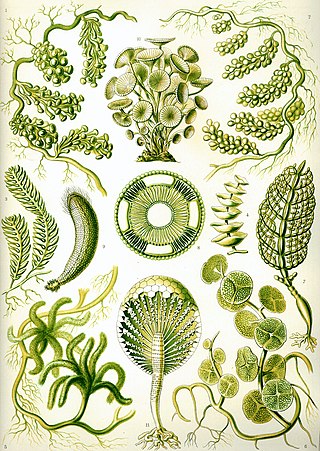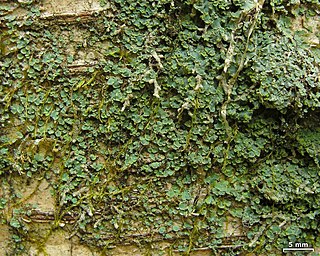
Algae is an informal term for any organisms of a large and diverse group of photosynthetic eukaryotes, which include species from multiple distinct clades. Such organisms range from unicellular microalgae such as Chlorella, Prototheca and the diatoms, to multicellular macroalgae such as the giant kelp, a large brown alga which may grow up to 50 metres (160 ft) in length. Most algae are aquatic organisms and lack many of the distinct cell and tissue types, such as stomata, xylem and phloem that are found in land plants. The largest and most complex marine algae are called seaweeds. In contrast, the most complex freshwater forms are the Charophyta, a division of green algae which includes, for example, Spirogyra and stoneworts. Algae that are carried passively by water are plankton, specifically phytoplankton.

The Chlorophyceae are one of the classes of green algae, distinguished mainly on the basis of ultrastructural morphology. They are usually green due to the dominance of pigments chlorophyll a and chlorophyll b. The chloroplast may be discoid, plate-like, reticulate, cup-shaped, spiral- or ribbon-shaped in different species. Most of the members have one or more storage bodies called pyrenoids located in the chloroplast. Pyrenoids contain protein besides starch. Some green algae may store food in the form of oil droplets. They usually have a cell wall made up of an inner layer of cellulose and outer layer of pectose.

Chlorophyta is a division of green algae informally called chlorophytes.

A lichen is a hybrid colony of algae or cyanobacteria living symbiotically among filaments of multiple fungi species, along with yeasts and bacteria embedded in the cortex or "skin", in a mutualistic relationship. Lichens are the lifeform that first brought the term symbiosis under biological context.

The green algae are a group of chlorophyll-containing autotrophic eukaryotes consisting of the phylum Prasinodermophyta and its unnamed sister group that contains the Chlorophyta and Charophyta/Streptophyta. The land plants (Embryophytes) have emerged deep in the Charophyte alga as a sister of the Zygnematophyceae. Since the realization that the Embryophytes emerged within the green algae, some authors are starting to include them. The completed clade that includes both green algae and embryophytes is monophyletic and is referred to as the clade Viridiplantae and as the kingdom Plantae. The green algae include unicellular and colonial flagellates, most with two flagella per cell, as well as various colonial, coccoid (spherical), and filamentous forms, and macroscopic, multicellular seaweeds. There are about 22,000 species of green algae, many of which live most of their lives as single cells, while other species form coenobia (colonies), long filaments, or highly differentiated macroscopic seaweeds.

Chlamydomonas nivalis, also referred to as Chloromonas typhlos, is a unicellular red-coloured photosynthetic green alga that is found in the snowfields of the alps and polar regions all over the world. They are one of the main algae responsible for causing the phenomenon of watermelon snow, where patches of snow appear red or pink. The first account of microbial communities that form red snow was made by Aristotle. Researchers have been active in studying this organism for over 100 years.

Desmodesmus is a genus of green algae in the family Scenedesmaceae. It is the only chlorophyll-containing organism known to have caused human infections in immunocompetent individuals. All known cases involved open injuries occurring in fresh water.
Dictyochloropsis is a genus of unicellular green alga of the phylum Chlorophyta. This genus consists of free-living algae which have a reticulate (net-like) chloroplast that varies slightly in morphology between species, and that when mature always lacks a pyrenoid. Dictyochloropsis is asexual and reproduces using autospores.

Planktosphaeria is a genus of Chlorophyceae of the green algae. It was first described by the phycologist Gilbert Morgan Smith in 1918, with Planktosphaeria gelatinosa as its type species. Species of Planktosphaeria are commonly found in freshwater plankton around the world.
Pseudomuriella is a genus of green algae, specifically of the class Chlorophyceae. It is the sole genus of the family Pseudomuriellaceae. It is a terrestrial alga that inhabits soils.

Trebouxia is a unicellular green alga. It is a photosynthetic organism that can exist in almost all habitats found in polar, tropical, and temperate regions. It can either exist in a symbiotic relationship with fungi in the form of lichen or it can survive independently as a free-living organism alone or in colonies. Trebouxia is the most common photobiont in extant lichens. It is a primary producer of marine, freshwater and terrestrial ecosystems. It uses carotenoids and chlorophyll a and b to harvest energy from the sun and provide nutrients to various animals and insects.
Pseudodictyochloris is a genus of green algae, in the family Actinochloridaceae. It is found in soils.

Autospores are a type of spores that are produced by algae to enable asexual reproduction and spread. They are non-motile and non-flagellated aplanospores that are generated within a parent cell and have the same shape as the parent cell before their release. Autospores are also known as resting spores. Algae primarily use three different types of spores for asexual reproduction - autospores, zoospores, and aplanospores. Autospores occur in several groups of algae, including Eustigmatophyceae, Dinoflagellates, and green algae. One example of a colonial alga that produces autospores is Dichotomococcus. This alga generates two autospores per reproducing cell, and the autospores escape through a slit in the cell wall and remain attached to the mother cell. Some study on autospores and algae in general include looking into its use for biofuel, animal feed, food supplements, nutraceuticals, and pharmaceuticals.
Elisabeth Tschermak-Woess was an Austrian University lecturer, cytologist, and phycologist who worked with lichen photobionts. In 1994, Tschermak-Woess was awarded the Acharius Medal for her lifetime contributions to lichenology. She had a Festschrift dedicated to her in 1988, in the journal Plant Systematics and Evolution. Lichen taxa that have been named after Tschermak-Woess include the genus Woessia and the species Asterochloris woessiae.

Mastodia is a genus of lichen-forming fungi in the family Verrucariaceae. It has six species.
Trebouxia decolorans is a widespread and common symbiotic species of green alga that is found in association with different species of lichen-forming fungi. Some lichens in which it is the photobiont partner are Xanthoria parietina and Anaptychia ciliaris.
Trebouxia gelatinosa is a common symbiotic species of green alga in the family Trebouxiaceae. Formally described as new to science in 1975, it is usually found in association with different species of lichen-forming fungi.
Asterochloris is a genus of green algae in the family Trebouxiophyceae. It is a common photobiont in lichen, occurring in the thalli of more than 20 lichen genera worldwide. Asterochloris is distinguishable from the morphologically similar genus Trebouxia, primarily due to its deeply lobed chloroplast, the placement of the chloroplast along the cell's periphery before the initiation of zoospore or aplanospore formation, and its tendency to primarily reproduce asexually through the production of aplanospores.

Normandina pulchella, commonly known as the elf-ear lichen or blue heart, is a species of squamulose lichen in the family Verrucariaceae. This cosmopolitan species is widely distributed across both hemispheres, where it thrives in moist microhabitats. It favours moss-covered deciduous trees and rocks, often colonising over mosses and bryophytes. It occasionally grows on bare bark and on other lichens. Distinctive features of N. pulchella include its bluish-green squamules (scales) with sharply raised margins, non-reactivity to standard chemical spot tests, and growth in humid habitats. Initially, Nannochloris normandinae, a green alga, was thought to be its photobiont. However, recent studies have revised this understanding, now suggesting Diplosphaera as the algal partner.

Pseudocyphellaria carpoloma is a species of corticolous (bark-dwelling), foliose lichen in the family Peltigeraceae. It is found in New Zealand, most commonly in northern coastal forest, but also on the west coast of South Island, on Stewart Island, and in the Kermadec Islands. The bright green upper surface, dichotomously branching nature of its lobes, as well as the yellow pseudocyphellae on the lobe margins and lower surface are characteristics that distinguish it from other New Zealand species in genus Pseudocyphellaria, such as P. billardierii, P. faveolata and P. rufovirescens.














